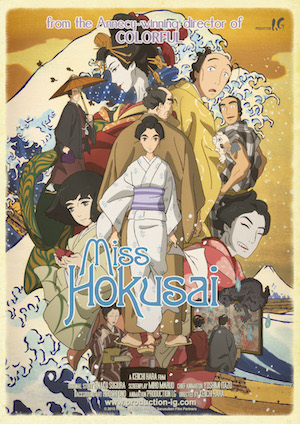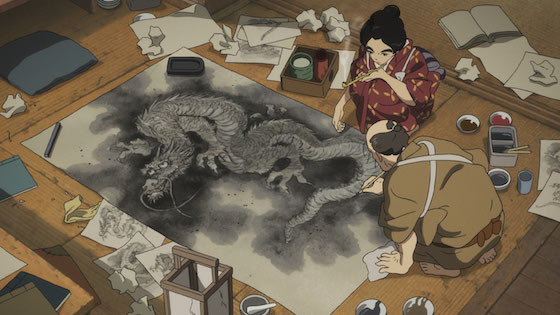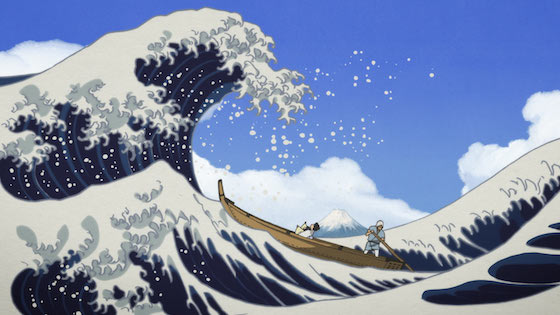Okay total disclosure, dear readers: This has been one of the hardest reviews I’ve ever had to write. Not because of content, no, but rather approach.
You see, this is a review of an episodic and thoughtful historical anime film from the great Production IG. Now, if I come to this film as an expert on anime, I could run into many an issue. Those who are less familiar or caring of the medium and its influences than I could instantly write me off as a dilettante, otaku geek and phase out much of the review. Those more familiar with the medium could decry me as a floundering, white-bread, poser Weeabu wannabe due to my failings to know every single reference or misattributing cultural milieu from the film. And yet, as a critic and lover of anime, I feel I must bring some of my knowledge to the quiet and fascinating Miss Hokusai.
You see I want to talk about the film’s structure, how its episodic and unfocused storyline actually points toward its origins as a manga, and how while having little in the way of actual plot the film uses metaphor and subplot as text rather than subtext. I want to talk about how this structure perhaps worked better on the comic page than on screen. I also want to counter, though, while this structure is odd while viewing the issues fade upon reflection and the film becomes richer in my mind the longer I spend away from it. I would maybe drop a reference to My Neighbor Totoro or Angel’s Egg to illustrate my point, but who has seen Angel’s Egg?
I could talk about the animation, which much like Production IG’s best work has a fluidity of movement that isn’t always a priority of Japanese animation. I’d maybe touch on how it animates faces, granting expression a level of subtlety that gives each person in the film a level of playful realness that is quite refreshing and pulls you into the narrative. I could further that the film utilizes heavy CGI for water effects and backgrounds but avoids the pitfalls that CGI in anime usually fall for, never seeming tacked on nor lazy. I would perhaps spend a good deal of time obsessing on this point due to the rareness of good CGI in anime, including director Keiichi Hara‘s previous film Colorful, where the CGI is obvious and sends you so far down the Uncanny Valley it takes several hours to pull yourself back out.
I could talk about the constant references to 19th century Japanese Art and folklore, how it not only captures the real historical characters in question (the great painter and printmaker Hokusai) down to a T but packs their world with as many references and touches from the time that it feels more like a contemporary film than a period piece. I could point to the complex and subtle references to the omnipresence of spirits in Shinto-Buddhism, and how those references act as the throughline of the film even more than the plot of the individual vignettes.
I could talk about how the film isn’t very fast paced or exciting or emotional, but rather a contemplative, rather Zen experience that requires thought and work to gain anything real from it, and then maybe I’d say something about how it’s “not for everyone” then get extremely concerned about my own pretensions. I’d maybe say something about this being one of my favorite films of the year thus far, but eventually I’d have to deal with the comment section coming at me for suggesting they go to a film so dull and unfocused. I might make a joke about that very thing then get skewered even more for said pretensions.
But I dunno. What do you think, dear readers?









Comments on this entry are closed.